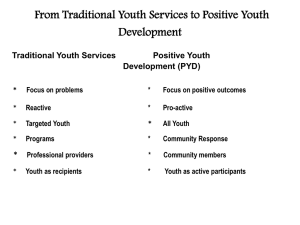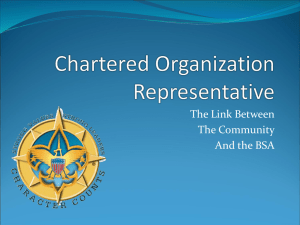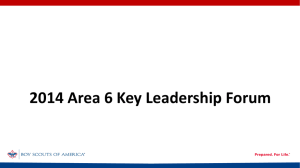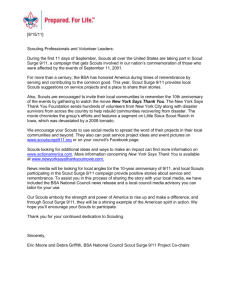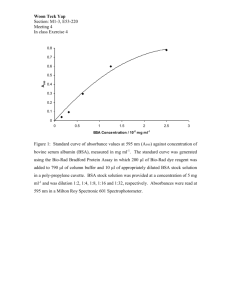Tufts 5 C's of Positive Youth Development
advertisement
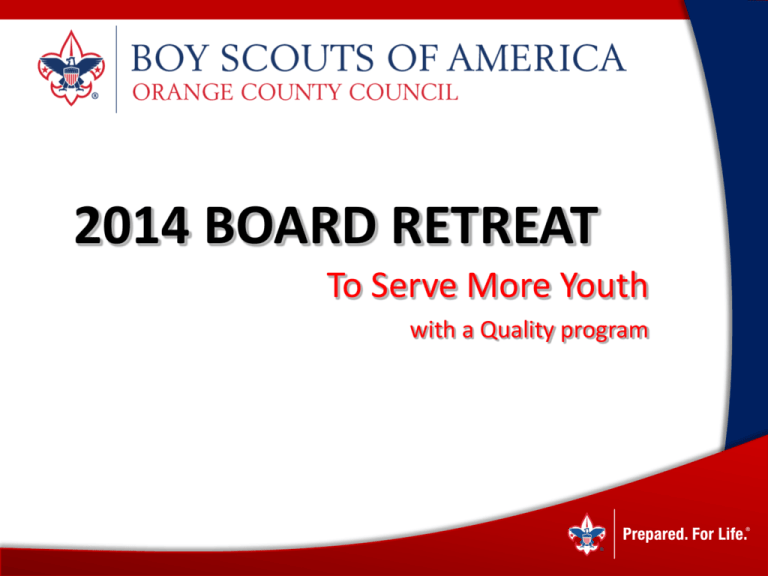
2014 BOARD RETREAT To Serve More Youth with a Quality program 1 Positive Youth Development in Scouting Brian Burkhard Institute for Applied Research in Youth Development Tufts University What is the Positive Youth Development (PYD) Perspective? The PYD Perspective: Six Core Concepts 1. Because of the potential to change, all youth have strengths. 2. All contexts have strengths as well. These strengths are resources that may be used to promote positive youth development. 3. These resources are termed “developmental assets”. They are the “social nutrients” needed for healthy development. The PYD Perspective: Six Core Concepts 4. These assets are found in families, schools, faith institutions, youth serving organizations, and the community more generally. 5. If the strengths of youth are combined with ecological developmental assets, then positive, healthy development may occur. 6. We should be optimistic that it is in our power to promote positive development among ALL youth and to create more asset-rich settings supporting such development among ALL youth. The “Big Three” of Youth Development Programs What features of youth development programs promote PYD? Youth Development Programs which are marked by “the Big Three:” 1. 2. 3. Positive and sustained adult-youth relations; Life-skill building curricula; and Opportunities for youth participation in and leadership of valued family, school, and community activities are key ecological assets linked to the development of PYD and youth Contribution and to lower levels of risk/problems behaviors How Do We Promote PYD AND CONTRIBUTION? Youth Development Programs Marked by the “Big 3” Program Characteristics influence PYD and Civic Behaviors Youth leadership Sustained youth-adult partnerships Skill-building activities PYD CommunityBased Youth Development Programs Civic Contributions Competence Individual Strengths Community Contribution Confidence Connection PYD Ecological Assets (Delivered by Youth Development Programs) Caring Character TIME Reduced Risk Behavior Scouting The Five C’s 1. Which of the 5 C’s is Orange County Council best at delivering on? Competence Confidence Connection 2. Which of them is Orange County Council weakest at delivering on? 3. What is a way that we can use our strength to improve upon a weakness? PYD Caring Character Grit in Scouting • What is grit? –“A passionate commitment to a single mission and an unswerving dedication to achieve that mission” –A perseverance and passion for long-term goals –What can grit predict? • West Point • Spelling Bee • Graduate Program Success Rate • “How Children Succeed” concepts in Scouting –“A safe place to fail” –Building life skills for future success • Goal-setting • Overcoming obstacles and failure Adverse Childhood Experiences (ACEs) • 11% experienced emotional abuse. • 28% experienced physical abuse. • 21% experienced sexual abuse. • 15% experienced emotional neglect. • 10% experienced physical neglect. • 13% witnessed their mothers being treated violently. • 27% grew up with someone in the household using alcohol and/or drugs. • 19% grew up with a mentally-ill person in the household. • 23% lost a parent due to separation or divorce. • 5% grew up with a household member in jail or prison. The Big Questions being addressed by BSA include: • What makes Scouting “Scouting?”: Methods, Values, and Outcomes Methods Values Outcomes • Ideals • Patrols • Uniforms • Advancement • Adult Association • Personal Growth • Leadership Development • Outdoors Scout Oath & Law Duty to God Character Development Citizenship Physical Fitness Leadership Competence Individual Strengths Community Contribution Confidence Connection PYD Ecological Assets (Delivered by Youth Development Programs) Caring Character TIME Reduced Risk Behavior Application in Orange County Council Alignment with the Strategic Plan • Optimizing Scouting’s Impact • Enhance Talent Management & Leadership • Robust Use of Our Council Facilities • Build a Sustainable Funding Model • Study and Research Measuring Outcomes of BSA Programs Character And Merit Project • Youth development (YD) programs seek to impact the character of youth in a manner that enhances their individual health and achievement (e.g., in school) and enables them to contribute positively to, and to be leaders of, their communities and the nation. • Accordingly, the Big Question addressed in this research is whether a YD program directed to the enhancement of character in youth can, in fact, promote character development among America’s diverse young people. • Does Boy Scouts of America (BSA) constitute such a program? Character And Merit Project • Determine if Boy Scouts promotes character in youth • If so, examine how Boy Scouts promotes character in youth using data from Scouts, parents, and leaders Measuring Character among BSA Participants: Research with the BSA Participants Based on the results of pilot research with youth from the Minuteman Council, we used measures of seven characterrelated attributes associated with the Boy Scouts Oath and one attribute associated with the positive youth development model to create a new measure of character Scouting constructs: Trustworthiness, helpfulness, kindness, obedience, cheerfulness, thrift, and reverence PYD construct: Future-mindedness Measuring Character among BSA Participants: Research with Cub Scouts Youth Questionnaire: Sample Items for Kindness Measuring Character among BSA Participants: Research with the BSA Participants • • • • • • • Kindness Obedience Reverence Cheerfulness Thriftiness Trustworthiness Helpfulness • Academic Competence • Future-Mindedness • Goal-setting • Scouting Engagement Measuring Outcomes • Use the character measure (kindness, obedience, reverence, cheerfulness, thriftiness, trustworthiness, helpfulness, future mindedness) online • Use the measure of the Cs of PYD and of Contribution developed by IARYD online • Monitor growth of Character, Contribution, etc. through repeated use of surveys • Compare growth across different BSA locations, programs, “dosage levels,” and in relation to non-Scout groups Thank You! Research for the BSA’s Character and Merit Project was made possible by support from the John Templeton Foundation.
